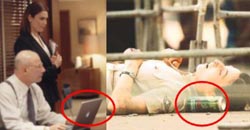Submitted by Diane Farsetta on
 The U.S. Federal Communications Commission (FCC) "is expected to open a formal proceeding about new rules requiring more disclosure of product placement." The "in-show advertising" practice is popular with marketers trying to "reach consumers who skip commercials." Product placement spending "increased 33.7% to $2.90 billion in 2007 from a year earlier," with "The Biggest Loser," "American Idol" and "The Apprentice" having the most product placements on network television. To improve disclosure, the FCC will consider requiring "notices similar to what political candidates must say before or after campaign ads." The agency will also "examine whether embedded advertisements violate FCC rules on children's programming, which require a few-second break in between the show and an ad. Commissioners will look at whether new product-placement rules need to be extended to cover cable programmers, which are currently exempt." Five years ago, Commercial Alert urged the FCC to require that product placements be "identified when they occur," instead of at the end of a show. The FCC didn't include that proposal in its new rule-making proceeding.
The U.S. Federal Communications Commission (FCC) "is expected to open a formal proceeding about new rules requiring more disclosure of product placement." The "in-show advertising" practice is popular with marketers trying to "reach consumers who skip commercials." Product placement spending "increased 33.7% to $2.90 billion in 2007 from a year earlier," with "The Biggest Loser," "American Idol" and "The Apprentice" having the most product placements on network television. To improve disclosure, the FCC will consider requiring "notices similar to what political candidates must say before or after campaign ads." The agency will also "examine whether embedded advertisements violate FCC rules on children's programming, which require a few-second break in between the show and an ad. Commissioners will look at whether new product-placement rules need to be extended to cover cable programmers, which are currently exempt." Five years ago, Commercial Alert urged the FCC to require that product placements be "identified when they occur," instead of at the end of a show. The FCC didn't include that proposal in its new rule-making proceeding.

Comments
stephane mot replied on Permalink
covert advertising
Product placement is gaining momentum because it has a longer lasting effect (ie program reruns, podcasts*) and a deeper impact (ie embedded in a consistent scenario, promotion by a rich character, compared to a 8 second spot), with a relatively cheap tag price.
In Korean dramas / soap operas (now major export items), some logos are now blurred - which actually draws the attention and sometimes favorises brand recognition (ie cars, consumer brands with colorful packaging).
In Europe, regulators tend to set strict rules, and broadcasters are often fined when they cross the thin line (ie the French CSA http://www.csa.fr/actualite/dossiers/dossiers_detail.php?id=22341&chap=2608 or the Belgian CSA http://www.csa.be/system/document/nom/823/CAC_20080529_decision_RTLTVi_publicite_clandestine.pdf ).
Fining broadcasters and forcing them to edit their programs is a much better deterrent than demanding a message at the beginning or the end of the show - who reads the credits anyway ? And "the few-second break" law would efficiently complete the arsenal.
______________________________________________________________________________________
Stephane MOT -
blogules and other Weapons of Mass Disinformation
_____________________________________________
* the rise in podcasting, TiVoing and VOD is actually a key driver for embedded ads